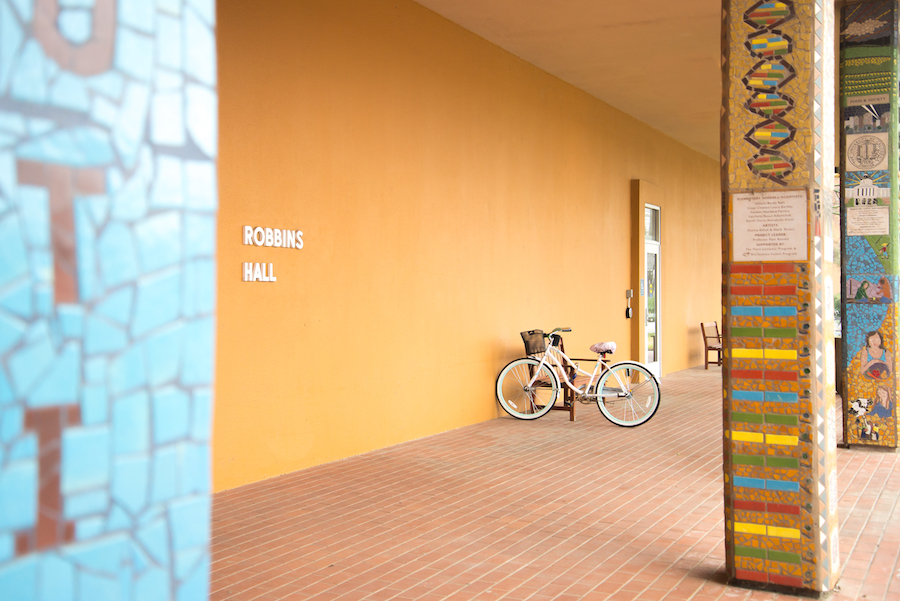
A look into location for plant science, revolutionizing research
Robbins Hall catches the eye of any passerby with the large, colorful space it occupies and the remarkable six pillars at its entrance — each embellished with specific life-science mosaics, including illustrations for the ideas of evolution, genetics, sustainability, agriculture, plant pathology and plant weeds.
As part of the UC Davis Art/Science Fusion program’s community outreach and spearheaded by ceramicist Donna Billick, post-docs brought each pillar to a local school in Davis to teach children concepts of science, and allowed them to lift these concepts out of books and into three-dimension through art. The beauty of life science and furthermore the beauty of community effort have been made into works of art, appropriate for the goings-on in Robbins Hall.
Besides the UC Davis plant transformation facility, which provides cost-effective services for the plant research community, another asset of Robbins Hall is its newly renovated laboratory facility. Professor Jorge Dubcovsky and his team use this new facility for betterment of wheat.
“The major goals of my program are to gain a better understanding of the effects of allelic variants of wheat genes that are relevant to agriculture and to develop the tools required for an efficient manipulation of these genes in wheat improvement,” Dubcovsky said in an email interview.
This program requires the incorporation of a broad range of research projects having to do with the biology of the crop.
“[These projects] include whole genome studies, mapping, positional cloning, marker-assisted selection, and a traditional breeding program,” Dubcovsky said. “This integration has provided our group the ability to discover and deploy new genes or gene variants into commercial wheat varieties.”
Over the years, Dubcovsky and his team have brought about many tangible changes in wheat production, along with educating the next generation of researchers.
“We published [over] 210 peer reviewed papers that have been referred [more than] 12,500 times,” Dubcovsky said. “We released 15 wheat cultivars (and one malting barley) and 55 improved germplasm. I trained 22 Ph.D. students and nine M.S. students.”
“We are in the new remodeled section […] about 30 members of project scientists, post-docs, graduate students, and 4 to 7 undergrads are working in the lab,” said Francine Paraiso, a lab manager and a research technician for Dubcovsky. “We moved here [to Robbins Hall] in 2011, but before then Jorge […] was in an old lab in Hunt Hall. We got lucky to get upgraded to the newly remodeled place.”
Dubcovsky continues to make strides in this field, earning national, and even international recognition. In the Robbins Hall laboratory facility, his team has cloned the genes that control wheat flowering, frost tolerance and forms of natural rust resistance.
“I have been leading large consortiums of USA wheat public breeding programs for the last 15 years that received multiple awards from USDA,” Dubcovsky said. “I have been elected as a member of the National Academy of Science in 2013, and in 2014 I received the Wolf World Prize in Agriculture.”
These awards are held in a location well-known for its history in the field. Robbins Hall was named after Wilfred William Robbins, one of the pioneers in agricultural sciences. He was particularly interested in botany, and has authored several books along with widely published research. Established under his name, the Wilfred William Robbins scholarship in the college of biological sciences is specifically catered to students majoring in botany.
Tyson Howell is a post-doc that works in Dubcovsky’s lab. As an undergraduate at Davis, he worked as a lab technician and applied to the graduate program. He has been working on plant genetics research for a while, and is now working with wheat, specifically drought tolerance. Howell began his journey planning to become an engineer, but completely shifted gears.
“I was really interested in engineering, but I’m not the biggest fan of math, which is basically all engineering is,” Howell said. “But I liked creating and organizing things, and I started hearing about biotechnology, so I started getting interested in genetics that way. Right now nothing I do is really transgenic, but I’m still using genetics to do things.”
Visiting Japanese scholar, Takanori Yoribe, is excited to learn about plant research and some of the most novel techniques here at Davis.
“I applied for a government program in Japan,” Yoribe said, “and I was sent here to learn state-of-the-art things, like techniques and what kind of research is done in UC Davis. I’m doing research with Professor Abhaya Dandekar using walnuts.”
All these milestones and opportunities do come at the price of hard work, however.
“I think that everything that we do is important.,” Paraiso said, “and just like any research it takes a long time and a lot of trial and error and hard work.”
Robbins Hall is a hotspot for anyone interested in the plant sciences. Its this location, built on six pillars of UC Davis’ agricultural history, that allows research like Dubcovsky’s to flourish.
“Almost all areas of plant biology are well represented here,” Dubcovsky said. “For me, being at UC Davis has been like being a kid in a candy store. I have enjoyed my experience as professor and the exciting interactions with my colleagues!”
Written by: Sahiti Vemula – features@theaggie.org



